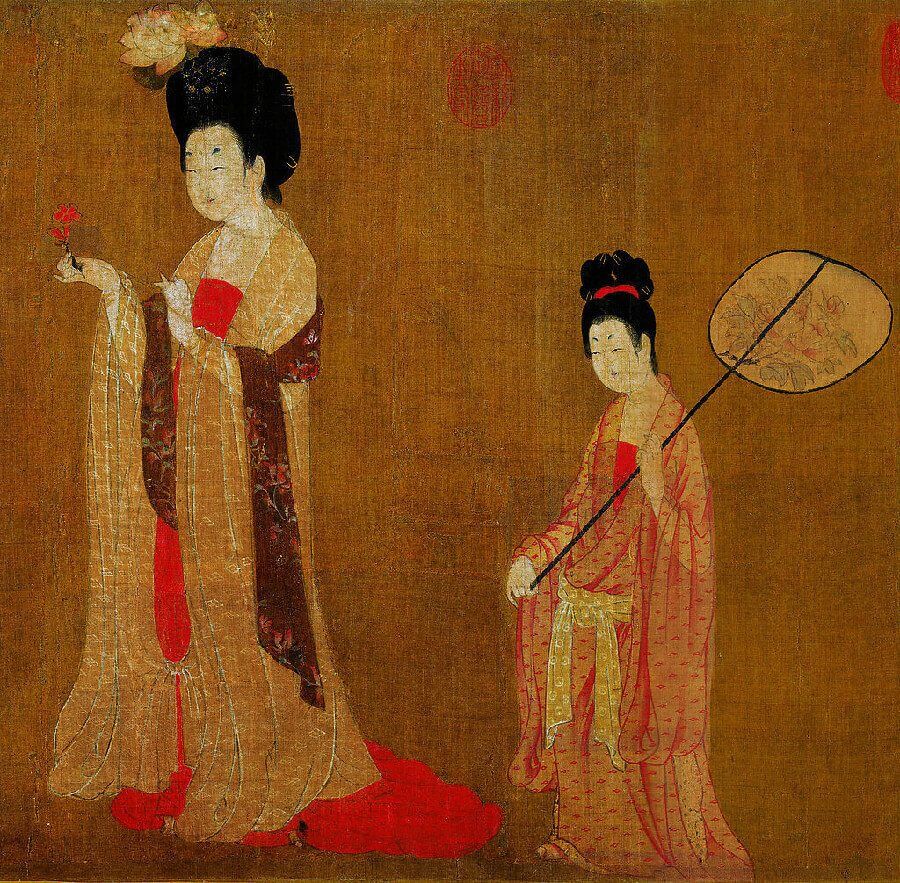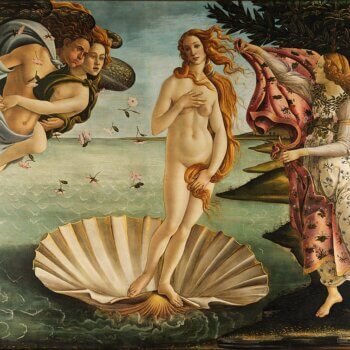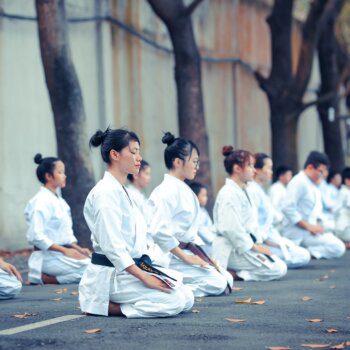Laws and institutions reflect the culture while culture constitutes the motive and momentum to shape laws. The Tang Code, which was created during the Tan dynasty, and became the basis for later dynastic codes in China and also in East Asia with its sophisticated and detailed character enriched by civil statutes and regulations, made the Tang the high point of the imperial Chinese legal system. The codification of laws developed in the Tang dynasty was the source of the law for the Song, Yuan, Ming and Qing dynasties, and it reflects not only the Tang, but the whole Chinese culture. In the light of these, this paper focuses on the Tang Code, and the place of women in the Code in terms of Confucianism, which was its main pillar together with Legalism.
The Han dynasty was the first truly unified regime, and after its end, no empire could implement a consistent code for the next four centuries. Even though the Sui dynasty (AD 581- 618) concluded a written set of laws called the Kaihuang Code, its copies do not exist. It was the Tang dynasty that applied a central set of laws, the Tang Code, to the empire. The term Tang dynasty was first established by Li Yuan, a military general who led a revolt against the existing Sui dynasty by declaring a parallel dynasty in 617.

As the earliest Chinese Code reaching the present day in its entire form, the Tang Code was a detailed code of laws and administrative functions which was established and used during the Tang dynasty to control the Tang’s vast territories. It took its roots in the code of the Northern Zhou dynasty that was itself based on the earlier codes of the Cao-Wei and Western Jin. (Gernet, 1996, 244) In order to smooth the earlier laws and physical punishments, and defuse social tensions in the Tang territories, the Code was created in AD 624 at the request of Emperor Gaozu of Tang. After further revisions in 627 and 637 under Emperor Taizong, the Code was completed with a commentary in 653 under Gaozong. (Gernet, 1996, p.244) Although there were revisions in later times, the Tang Code was largely preserved by later codes such as the early Ming dynasty (1368–1644) code of 1397. (Andrew, 2000, 25) (Ebrey, 1999, 158)
The Tang Dynasty had the most comprehensive legal system in comparison with the other dynasties in Chinese history. The Tang Code was composed of twelve sections containing more than five hundred articles. (Ebrey, 1999, 245) The Code addressed various issues largely distinguished into four main areas namely: Lu(criminal law), Ling (institutional regulations), Ge (administrative rules) and Shi (formulas of official documents). This code, which is just one among many that were developed in ancient China by various dynasties, has remained popular in modern studies as it is intact in its original form while other ancient penal codes are available in bits. The Tang code was a legal model for all subsequent dynasties up until the 20th century when the Republic of China was founded. (Wang, 2009, 699) Generally, the Code was applied universally in deference to Confucian’s social hierarchies, moral standards, cultural and legal standards. The Code thus stated laws and their respective punishment. It held in high regard social hierarchies to such an extent that punishment meted out to offenders of a given crime differed with social hierarchy. (Ropp, 2010, 54) In the same manner, gender issues as recognized by Confucianism were upheld by the Code. According to Confucian ideas, women should be subservient to men as natural and proper order. At the same, men should always honor and respect their mother and mother-in-law. The law thus largely reinforced specific issues of this highly patriarchal society that largely discriminated against women to an extent of containing some contradictions that were impractical to fulfill as this paper discusses.
One of areas that the Code surmounted women was in marriage. Marriage held a central place in the social life of the Chinese society in the Tang Dynasty. Marriage reconfigured kinship boundaries, class, ritual obligations and law applications. It was viewed as a union that ensured continuity of family, life and society. The family also played an integral role in creating a chance for the practicing of family rituals as enshrined in the huhun in the annotated Tang code. (Pee, 2012, 187) In all these, marriage under the Tang Code presented several new changes to the place of women in society. The Code meant that married women would no longer be exiled for life from society for crimes committed but were instead subjected to corporal punishment. (Johnson, 1995, 226) The secondary role that women played to men also meant that they received lenient punishment compared to men. For instance, if a woman led a crime, she would not be liable to punishment if any male was involved in the crime as the code already assumed that women exclusively take orders from men and not the other way round. (Johnson, 1995, 226) In terms of educating women, the Tang dynasty and specifically the Tang Code provided better conditions and room for women to receive education, which was a break from the traditional upbringing of women that centered on the virtues of being docile and obedient. (Lee, 1995, 345) The Code also dictated clearly the virtues expected in women through the seven feminine virtues developed by Ban Zhao (Pan Chao).

These virtues have been perceived both positively and negatively. The positive approach views the virtues, which were part of the four qualifications of a woman (womanly virtue, womanly words, womanly bearing and womanly work), as a sure way to offer guidance and moral education to ancient Chinese women. (Lee, 2012) On the other hand, the negative approach to these virtues sees them as a way and method or perpetuating or institutionalizing discrimination of women despite the law being drafted by a fellow woman. These virtues dictated every aspect of women’s lives from how they interacted with one another and even how they interacted with their children and spouses. Deviance from the said virtues was not acceptable and consequences included among others divorce.
The first feminine virtue was meekness and humility. A woman was expected to be meek and humble in front of her husband and male relatives including her sons. (Zhao, 95) While Zhao as a woman identified the importance of this virtue, it was the role of the father of a young girl to teach the virtue of meekness and humility though a ritual performed when girls were just three days old. It involved the placing the child under the bed alone with a spindle as a first toy. This was done to teach her about her inferior position in the household and the importance of hard work represented by the spindle. The father was expected to fast and do penance and report to the ancestors the arrival of a female child in the family. This prepared the girl for a place and acceptance to offer ancestors sacrifices in forms of food and wine. Women played an integral role in these sacrifices and their acceptance by the ancestors at a tender age through the intervention of the father allowed for the acceptance of the sacrifices made in family rituals once they got married. (Zhao, 97)
The second virtue related to a woman’s relationship with her husband or what was commonly known as the “Husband as Guidance” doctrine. (Zhao, 96) (Lee, 1995, 305) This doctrine was aimed at guiding the relationship between a husband and a wife with the woman playing the submissive and timid feminine role and the husband playing the masculine and respect-demanding role. For this reason, each young boy had to be taught how to be a man and a good husband and the same for each and every girl. The doctrine also reiterated the place of women in a family hierarchy by stating that “The father is the god in the eyes of the son, so is the husband in the eyes of the wife… A woman treats her father as the god when single and treats her husband as the god when married… and ‘Be obedient to your father before marriage, your husband after marriage and your son when the husband dies’ ”. (Lee, 1995, 347) This view was also highly supported by the state which used male members fo the society to maintain order in families and thus the larger empire.
The third virtue called for a differentiation of the conduct between males and females. This view according to Pan Chao was borrowed from the yang–yin philosophy, which states that despite masculine, and feminine forces being apparently opposite, they should work in a complementary manner. In this case, man is the yang, which represents hardness while a woman is the yin that represents softness. Therefore, a man should always be strong and the woman soft and not the other way round. (Lee, 1995, 347) This virtue also recognized the need for mutual affection and respect between couples as a key pillar to the marriage institution. Although husbands were allowed by the code to beat and scold their wives in case of disrespectful behavior or contempt towards the husband, such actions were viewed to undermine the institution of marriage.
The fourth virtue pertained to a woman’s conduct. There were four recognized standards or elements that were used to judge the conduct of a woman namely ethics, words appearance and domestic work. (Zhao, 98) The basic idea behind the setting up of these standards was to indicate to women that they do not need to be superhuman or super-talented to be considered a woman. The standard was just meant to guide their actions, and behavior to be consistent with custom and convention. (Zhao, 98) For instance, in terms of appearance, a woman should be neat and clean to acceptable standards. Nonetheless, the different social classes of the society implied that the expectations varied across the levels. In a similar manner, the punishment for violation of the set standards varied across the social classes but the code ensured that the variation was just and fair. (Johnson, 1995, 220)

The fifth feminine virtue called for women’s devotion to their spouses. A wife was expected to be devoted to the husband even after his death. The notion that the husband was a “god” to the wife as mentioned earlier in the second feminine virtue implies that a woman cannot abdicate her religion or switch allegiance from her god to another. (Lee, 1995, 347) Therefore, a woman was not expected to remarry after the death of the husband whilst a man was not expected to marry a widow. On the other hand widowers were allowed to remarry in order to ensure continuity of the family and the society at large. This dominance and favoritism of men in this ancient society was also evident in the fact that the code gave articulate instructions in how wives would meet the needs of their husbands but minimal instructions on how husbands would meet the needs of their wives. In one instance, it is noted that a woman shall not at any moment violate the principle of righteousness and propriety or even gather with other women for parties or fun purposes. (Zhao, 99) In short, women were there to meet the needs and obey their husbands or fathers and meet cultural and society expectations of them enshrined in the Tang Code.
The sixth feminine virtue called for a woman to bend her own will to accommodate the will of others. (Zhao, 99) She was required to bend her own will to win the joy and favor of her husband and the in-laws. In regards to parent in-laws, women were expected to obey the wishes of their parent in laws especially where dispute with husband was involved and divorce was being contemplated. Additionally, women were expected to show recognition of the Confucian family and social hierarchy as upheld by their husbands. While husbands regarded sons as more important than daughters in that era, the reign of emperor Wu Zetian, China’s only female emperor, brought confusion. With Zetian promoting the course of women, girl children were favored and even baby boys killed. This alone was in contradiction of the Tang code which placed males higher than women in the social hierarchy and required women to be timid at in an empire ruled by a woman. (Ropp, 2010, 55)
The seventh and last feminine virtue emphasized on the need to maintain cordial relations with husband’s siblings. The woman was required to recognize and appreciate the acceptance given to her by the in laws as part of her adopted family. Given that the family was a very important part of society then, a husband might have received input from his family choosing a spouse or even divorcing her. It was therefore the role of a woman to ensure that she was accepted and retained in her adopted family through marriage by continually impressing the in-laws and in the process impressing the husband. It was very hard for a man to divorce a woman he was married to if his parents and family were very fond of her. (Benn, 2002, 247-248) A wife was also required to strengthen the relationship between her husband and his siblings and parents. Special interest was given to the relationship between a wife and the husband’s younger sister who was assumed to have a closer relationship with the husband than with other siblings. Therefore, a woman was required to befriend this younger sister to cover her weaknesses and highlight her strengths in the belief that as her ally, she would praise her in front of the husband or curse her in front of the husband. (Zhao, 101)
The Tang Code also bound women through the ten abominations law. These laws were largely grouped into two categories-abominations against state and abominations against family and society. These Abominations are the most severe offenses under the Tang Code. Abominations against the state included leading rebellion, plotting great sedition, plotting treason, great irreverence and unrighteousness. Abominations that undermined the basic family unit included contumacy, depravity, lack of filial piety, discord, and incest. (Wang, 2009, 701) Filial piety was considered the most important in that it comprised of respect to parents (in-laws), elders and ancestors. Ancestors in Chinese culture were accorded utmost respect and commemorated through ancestor worship, rituals and the Qingming Festival. This was driven by the belief that the ancestors had influence on the lives of the living.

Marriage was an important social practice for the Tang dynasty both for the living and the dead. The ancestors were involved in marriages through several rituals that aimed to sanctify the union and even allow ancestors to accept a new wife into the family. Some marriages were even performed posthumously with a person being married to the soul of an ancestor. (Benn, 2002, 243) The act of marriage also played a critical role in reinforcing the inferior position of women in that particular society. For one, marriages were arranged by parents of a man and a woman through an intermediary known as matchmaker. The family of the man had more control on the choice of spouse than the girl’s family. The woman had no choice in deciding about divorce. Again, the woman had no say in dictating her relations with the in-laws. For this reason, some marriages were not guided by perceived match-up or love but the need to continue with a social system that ensured continuity and gender hierarchy. (Benn, 2002, 243) The wedding process was also evident of the suppression of women.
The Tang Code authorized the use of matchmaker. Prospective bride and groom were not allowed to meet before marriage or court in the belief that it would encourage premarital relations, which were against the Tang Code. (Dull, 1969, 39) The Code also set the legal marriage age for males at 14 and for girls at 12. (Benn, 2002, 244) The marrying however varied widely by social class with upper class marrying earlier while the lower class married late at around 20-30. (Dull, 1969, 27) The law was strict on the age or couples with a man only allowed to marry a girl not less than half his age. However, the state was not involved in issuing wedding ceremonies though there was clear need to ensure the legal age was observed and that incest was not practiced. Incest was punishable to both wife and husband with the severity of punishment varying with the proximity of family relations. There were other marriages that were prohibited. For instance a woman was not allowed to marry a close kin of her deceased husband. Again marriages consummated during the mourning period for a parent or husband or during incarceration of a close relative were all condemned. Additionally, marriage between people with a similar surname was not allowed same as marriage across the rigid social classes. One of the reasons that marriage between people who shared surnames was because women and monks, who were regarded lowly in Tang China were only referred to by their surnames. (Tung, 2000, 180) A concubine was also not allowed to be elevated to a wife. (Pee, 2012, 190)
The Tang Code also recognized that marriages could end in divorce. As such, a man and a woman were allowed to divorce through mutual consent on various grounds. While a man was allowed to divorce a woman, a woman was not allowed o divorce a man even if the grounds set out for divorce were committed by the man. There were seven conditions under which a man could divorce a wife which comprised of (1) unfilialness to her parents-in-law, (2) bearing no son, (3) adultery, (4) jealousy, (5) malignant disease, (6) talking too much, and (7) stealing. (Wong, 1982, 269)
These conditions were deemed irreversible once committed by a woman but they could contest divorce on three conditions. First was having nowhere else to go such a lacking other close extended family members to support her. Second was having contributed significantly to increased wealth of her husband. Third, for having mourned for her parents in law. (Hinsch, 2010, 43) However, as earlier aforementioned, the conditions did not apply to men as women were not allowed to divorce women. These conditions were also largely contrasted against the six desirable qualities noted in prominent pre-Han period women. They include (1) motherhood, (2) honesty and intelligence (3) kindness and wisdom, (4) chastity and submissiveness, (5) righteousness and (6) speech and writing. (Swann, 1932, 82-90)

In conclusion, the Tang Code though meant create civil order gave undue attention to women. This confirms a clear indication that the society believed or the Tang Dynasty as the government of the day believed that women were most culpable to committing offences, hence they needed to be given clear guidelines. In fact, one of the most popular poems from the Tang Dynasty by Bao Si claims in part “Disorder is not sent down by Heaven, It is produced by women.” “Those who cannot be taught, cannot be instructed. These are women and eunuchs.” (Raphals, 1998, 64) As such, even books such as the Nu Tse (principles for women, 630 AD) were published aimed at guiding women on the best behaviors and conducts as extolled in the Tang code. This book in particular highlighted the virtues of historical Chinese female figures which women of the Tang dynasty were expected to emulate. The book comprised of thirty volumes in total. (Yao, 1983, 50)
On looks, women were expected to be beautiful to be admired by suitors and their husbands. One of the most controversial and contradictory law allowed by the Tang dynasty pertained to the practice of foot binding. While the code sought to somehow liberate women from repressive laws, the foot binding process, which aimed at achieving a small beautiful feet was self-defeating. This is because it hampered movement and even the productivity of women who were expected to work hard as part of a feminine virtue. (Goucher, 1998, 119)
It is clear that women of the Tang dynasty were weighed down by very high standards of moral and behavioral expectations with some being impractical. The inability to bear a son being a ground for divorce is simply absurd given that modern science has shown that it is men who determine a child’s gender. The women of that period were brought up to be seen, and not heard. Though there are cases that the laws were disobeyed during to their impracticality, women still remains largely the lesser gender. The desire to have children as young as 12 marrying only served to suppress women. Such knowledge is important to understand the history of Chinese culture and the cultures view on women in the modern world where gender equality is ongoing issue.





























